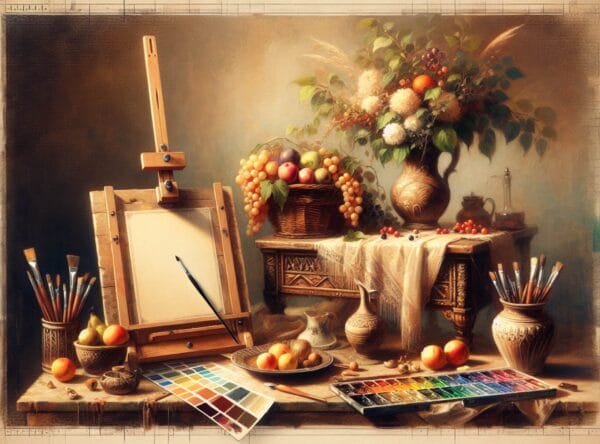Are you wondering why I’m posting about acrylics on a site exclusively about drawing? Acrylic paint is a versatile and accessible medium for artists of all levels. Its quick-drying nature and vibrant colors make it perfect for various painting projects that begin by drawing acrylic sketches.
Every painting begins with a sketch to inform the layout’s placement of shapes, colors, and zones. Whether you are a beginner or a seasoned artist, these “under sketches,” or pentimenti, can help guide your painting with acrylic planning strokes before applying thicker layers of opaque paint.
Unlock Your Creativity with Acrylic Sketches
Before you embark on a detailed project, sketch your ideas using acrylic paints. Mix different colors with water and apply them thinly to the canvas. Since acrylics dry quickly, blending them can be tricky. Use a wet-on-wet technique or work swiftly with a dry brush for different effects. If you want to start over or eliminate specific areas of your sketch, simply re-apply opaque acrylic gesso and wait for it to dry. Then, try sketching again until the composition pleases you.
Explore Composition with Acrylic Sketches
With this beginning, you may want to take your acrylic sketch on canvas to the next level using more acrylic paint or switch to oil paints. If you switch to oils, make sure the acrylic underpainting is bone dry; otherwise, your oil paint won’t adhere properly and will eventually flake off.
Here are some further tips on working with acrylic paints.
Acrylic Sketches to Abstract Art: Express Yourself Freely
Abstract art is a great way to experiment with acrylics without the pressure of capturing a perfect likeness. Start with a simple color palette and let your mood dictate the movement and flow of the paint. Use palette knives, sponges, or fingers to create textural elements and layers. Abstract art can be incredibly therapeutic and an excellent way to express your thoughts and emotions.
Try Impasto Techniques for Added Texture
Impasto is a technique for applying thick paint to the canvas to stand out from the surface. Acrylic paints are well-suited for impasto because of their thick consistency and quick drying times. You can use a palette knife to apply thick dollops of paint and create a three-dimensional appearance in your artwork. Try combining impasto with traditional painting techniques for a unique and tactile finish.
Landscape Paintings: Capture the Beauty of Nature
Landscape paintings are timeless classics, and acrylics can brilliantly capture the dynamism and color of natural scenery. Start by sketching out your basic composition, then block in the major colors and shapes. Work from the background towards the foreground, adding details and layers as you go. Don’t forget to play with light and shadow to give your landscape depth and realism.
Portraiture with Acrylics: A Modern Twist
If portraiture is your passion, acrylics can offer a fast-drying alternative to oils. To tackle this genre, start with an underpainting in a neutral tone and gradually build up layers and flesh tones. Acrylics can be used in thin glazes or thicker applications, allowing you to create a range of textures and details in your work. Study your subject and pay close attention to the play of light to create a lifelike representation.
Incorporate Mixed Media for Innovation
Acrylics play well with other materials, making them perfect for mixed-media art. Combine your acrylic paints with collage, pen and ink, or even digital images to push the boundaries of your artistry. Mixed media can help add visual interest and depth to your paintings and open new avenues for storytelling and symbolism.
Creating Minimalist Compositions
Sometimes, less is more, and a minimalist approach can have a powerful impact. Concentrate on simple shapes, a limited color palette, and a clear focal point. Use flat, even applications of color or create a slight gradient to convey depth. Minimalism can be an excellent restraint exercise and lead to a sophisticated and modern piece of art.
Acrylics offer a broad playground for artists to experiment, learn, and create. The key to success with acrylic painting is to be open to experimentation and to enjoy the process of making art. So grab your brushes, squeeze out some vibrant hues, and let your imagination guide your next acrylic artistry project.

